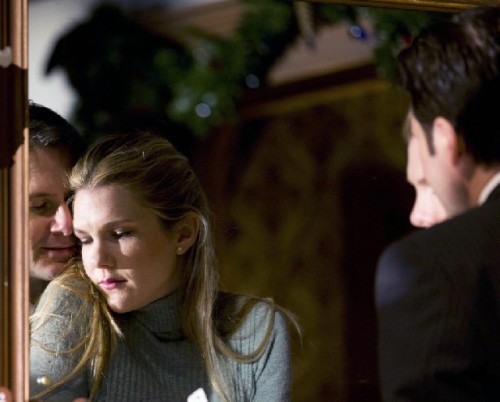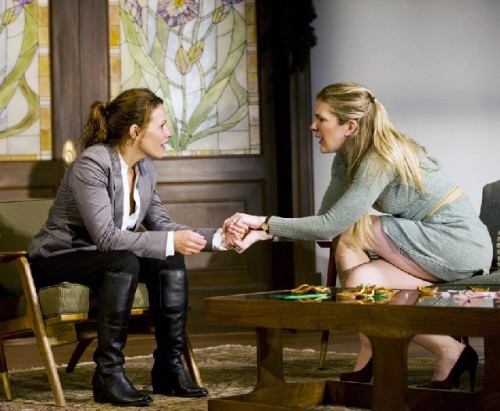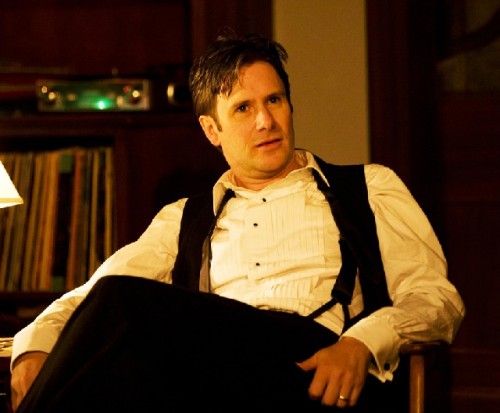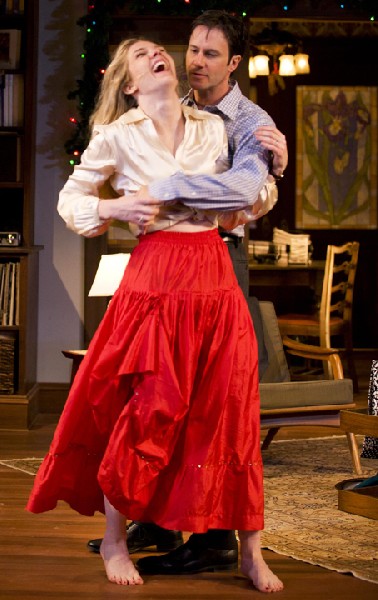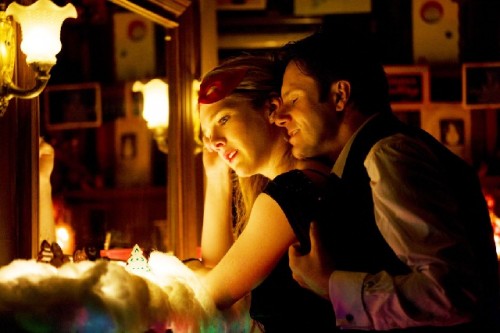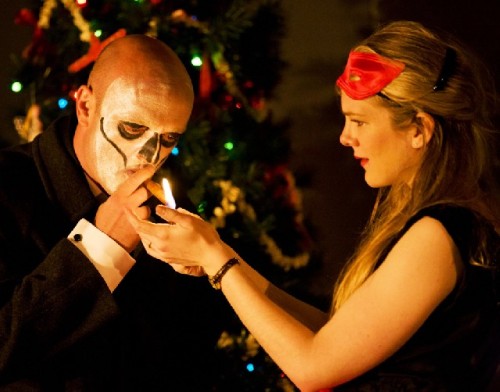Toying With Ibsen’s A Doll’s House
A Classic Crashes and Burns in Williamstown
By: Charles Giuliano - Jul 22, 2011
A Doll’s House
By Henrik Ibsen
Translated by Paul Walsh
Directed by Sam Gold
Scenic Design, David Korins; Costume Design, Kaye Voyce; Lighting Design, Ben Stanton; Sound Design, Jane Shaw; Movement Consultant, Dontee Kiehn; Production Stage Manager, Michael Alfianz; Production Manager, Jeremiah Thies; Casting, Calleri Castino.
Cast: Lily Rabe (Nora Helmer), Zanib Jah (Anne-Marie), Torvald Holmer (Josh Hamilton), Lili Taylor (Kristine Linde), Adam Rothenberg (Nils Krogstad), Matthew Maher (Doctor Rank), Eliza Huberth (Helene), Sol Sutter (Ivar), Rose Sutter (Emmy), Tashi (Tashi), Party Goers by the Ensemble.
Williamstown Theatre Festival
Nikos Stage
July 20-31
The great Norwegian playwright, Henri Ibsen (1828-1906) was 51 in 1879 when he wrote an enduring classic of modernism A Doll’s House. Between 1850 and 1899 he wrote 27 plays a number of which continue to be produced.
For the audience in the late 19th century, the transition of Nora Helmer (Lily Rabe), from little bird, plaything and pet of her possessive, shallow, smug, sexist husband Torvald Holmer (Josh Hamilton), to liberated woman was shocking and galvanic.
There are parallels to the great Russian novel, Anna Karenina, by Count Leo Tolstoy. He wrote the novel in installments from 1873-1877 so they are of the same period. These works with fascinating points of contrast occurred a generation after the novel of another middle class, fallen woman, Madame Bovary by Gustave Flaubert in 1856.
In the proto feminism of these works the Ibsen resonates most precisely with contemporary women. While Anna Karenina and Madame Bovary doomed themselves, leaving a life of security with utterly boring husbands to seek romance, adventure, and love, Nora Helmer walks out, leaving it all behind, including two sleeping children, because she has come to her senses. She will not spend another night in the bed of a stranger. The man for whom she risked and sacrificed everything to save his life. In the denouement of the riveting final act, Nora received nothing better than an offer to live a sham marriage as “brother and sister.”
While having lost everything for love, Anna Karenina throws herself under a train, Nora decisively walks out to find herself. At the end of the final act, in the middle of the night, after an evening of holiday celebration in which she danced the tarantella to please her husband and entertain their guests, slamming the door behind her.
Great stuff.
But not in this train wreck of a misguided, muddled update and deconstruction on the Nikos Stage of the Williamstown Theatre Festival. Before opening night the show has sold out its two week run. Those capacity audiences will have to sit thorough a long evening in three acts to find out for themselves that there is little or no substance in this attempt to rework a theatrical classic.
In her first season as artistic director of the Williamstown Theatre Festival Jenny Gersten has redefined the mandate of the Nikos Stage. Where in the past it has been a venue for new works and experimentation Gersten has widened the reach to include reworking standards including Streetcar Named Desire, which launched the WTF season, and A Dolls House which opened last night.
As a marketing and business strategy it is a producer’s decision which has resulted in strong ticket sales. So it may make sense for the bottom line. But, from an aesthetic point of view, it has been a disaster. Streetcar was problematic but had redeeming qualities. There is little or nothing, other than a superb and poignant performance by the remarkable Lili Taylor as Kristine Linde, to praise about this utterly forgettable production of such great material.
Ok, prove me wrong, go see for yourself. But caveat emptor.
When producers and directors update the classics the most familiar trick is to change the time and place. We see that currently in another misguided production currently on stage in the Berkshires. With decidedly mixed results Shakespeare & Company has relocated Romeo and Juliet from Renaissance Verona to a kind of generic anywhere.
Where A Doll’s House was shocking to 1879 Norway it has been fast forwarded, in a jumbled set by David Korins with yard sale furniture and practicals, as well as flea market, tag sale costumes by Kaye Voyce, and a mind boggling jumble of sound and musical selections by Jane Shaw.
From where we were located, with another critic, in boxes to the left and above the orchestra seats, a third of the set was invisible. By walking around during intermissions we noted that it entailed a fireplace and bookshelves buried in a corner. One would have to have been seated dead center to see into the study/ dining room of Torvald. So any action that transpired there, visually or audibly, was utterly lost on us.
With some critics given adequate seating with a view of the full stage, and some not, there was hardly a level playing field for accurately reporting on the production. By seat assignment the results were skewed and guaranteed uneven responses. There are consistent issues with obstructed view seating of some critics for the Main Stage of the Berkshire Theatre Festival. We can't report on what we can't see and hear. During opening night of the short run of Tommy, at the Colonial Theatre, some critics opted for another night when offered seats in the balcony rather than the traditional two on the aisle.
Examining what one could see of the set was utterly confusing. Leading to the den were sliding doors with an art nouveau design. The 1879 launch of the play would have been a tad early for that. As Astrid commented to me the mish mash of furniture evoked Danish Modern of the 1960s. If so, Nora should have been dressed in Marimekko. That would have been terrifically clever.
The play transpires over the Christmas Holidays. The decorations were consistent with the 1960s. But the music for the opening scene was Bing Crosby. He recorded the standard "White Christmas" in 1954. But is that right for a living room in Norway in what we are assuming to be the 1960s? Another musical selection was by the Glenn Miller Band. He died over the English Channel during WWII. In the second act we heard a snatch of Bo Diddley which would evoke the birth of rock ‘n’ roll in the 1950s.
We were on the lookout for other signifiers of time and place. Much was made of elaborate stairs that led down to a lower level entrance to the Holmer residence. And to a closet, which we never saw, below the stairs, which we glimpsed, that led to the bedrooms on the upper floor and a ballroom. Indeed how did this modest, middle class home boast a ballroom where Nora danced the Tarantella?
Are you following this? Yeah, I know, it’s confusing.
Much was made of buzzing people in and out of the front door. Or listening to the intercom. That was Definitely not Ibsen. In the third act when the blackmailer Nils Krogstad, played with nicely dark menace by Adam Rothenberg, has a change of heart and returns the documents Torvald does something totally ridiculous. Logic would dictate that he toss the contract, that Nora foolishly forged, into that roaring fire place which we never saw. It is Christmas in Norway after all. But no. As the audience howled in disbelief we heard the churning sound of a paper shredder.
It evoked memories of Colonel Oliver North and his dishy assistant Fawn Hall destroying documents in the Pentagon at the dead of night. Talk about a misplaced time warp.
With so many gaffs you legitimately wonder who was minding the store and checking off on this production? At whose desk does the buck stop? Do we blame the director Sam Gold for not restraining Rabe and pacing the company? Shouldn't he have exerted more oversight of the set, sound/ music and costumes with their plethora of issues and mistakes? Or was it Gersten's call to check off and have final say on production issues? In this melay you might expect the ghost of General Alexander Haig to bound on stage stating "I am in control here."
We have saved the worst for last. The casting.
Lily Rabe was absolutely, totally, absurdly wrong to play Nora Helmer. If Nora is off kilter and misconceived then any production of A Doll’s House is doomed, as this was, within the first ten minutes of the first act.
To make Nora work, and to set up the reversal of the stunning third act, there has to be a credible emotional arc from Torvald’s obedient pet and eye candy to the troubled, worldly woman who finds herself and walks out on him.
From the first scene Rabe over acted, ran, skipped, and jumped frenetically all over the set. She just trampled and overwhelmed all of the other actors, except Taylor who remained calm and distant, in scenes with her. Even Krogstad was no match for her. So his instance on their similarities as criminals just never took hold.
Even in the 1960s, where Nora’s issues would be far more commonplace, her husky voice and strident delivery was hopelessly adrift from the nuance of Ibsen’s well crafted plot lines. She just trampled all of the petunias.
With all of Rabe’s manic running about we were shocked to be seeing so much of her bare legs and up her skirts. She played Nora more as a harlot than housewife. The woman in Ibsen reeks of reserve and modesty. In the tarantella scene she devolved into a Whirling Dervish. There was concern that she would hurl herself into the audience.
Having to work with the shrill and unmodulated, manic Rabe the other actors did their best to bring some order to the chaos. The Torvald of Josh Hamilton was game for the task and indeed had compelling moments. But from the get go he was outmatched and upstaged. So his ultimate emasculation and humiliation from domineering husband to neutered and abandoned spouse just never was credible.
When played well the role of Doctor Rank, the best friend and confidant of Torvald, can be compelling and poignant. It is revealed that part of why he shows up every day is because of love for Nora. Ibsen also endowed his character with congenital syphilis which in the scene with Nora is reaching its final horrible stage. After A Doll’s House, two years later, in 1881, Ibsen enlarged on that theme in Ghosts. It was given a strong production, two years ago, with Randy Harrison at Berkshire Theatre Festival.
But this Doctor Rank performed by Matthew Maher never had a chance. First, they put the sage and dignified middle aged gentleman in a ridiculously patterned ski sweater. He just looked silly. There were problems trying to understand his slurred diction. He was so miscast that there was never a prayer of believing that he might, even for a nano second, be a love interest and admirer of Nora. In the costume party sequence he came with makeup as a skeletal ghost. It was just too literal and grotesque. Shouldn’t even realist theatre leave a bit to our imagination?
The final scene between husband and wife was actually played quite well. It is late at night and the party goers trickle out. Torvald has had a splendid evening including too much champagne. But he sobers quickly with a barrage of bad news. They sit in the dark and talk, for the first time in their marriage, as equals. Finally, Rabe is not running about. She sits quietly with the reserve that might have prevailed in the previous two acts. But even here she rushed through the dialogue while Hamilton tried to slow it down with long pauses to absorb and react.
In the canon of theatre the final scene is Ibsen at his best. The entire long evening leads up to this phenomenal reversal and its nascent feminism. It was pretty stunning in 1879 and perhaps all too common today. There is a similar plot line in Three Hotels which is finishing its run on the WTF Main Stage. It also represents a woman who walks out on a failed marriage.
Ultimately, if we redo the classics, as we have every right to, it is imperative to both respect the legacy and recontextualize the work for a contemporary audience. That just didn’t happen with A Doll’s House. Playing loose and fast with Torvald's house did not make the audience feel at home.
This production deserves one of Doctor Rank’s calling cards with a black cross superimposed. No visitors allowed. Requiescat in pace.

